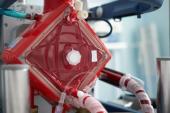Shock in COVID-19: Types, Triggers, and Treatments Differ, but Outlook Is Grim
In a sign of the viral disease’s varied effects, distributive shock outnumbered cardiogenic and few cases were tied to acute MI.

One in eight patients hospitalized with COVID-19 develop some form of shock, according to the American Heart Association’s COVID-19 Cardiovascular Disease Registry.
And regardless of whether the shock type is cardiogenic, distributive, or a mixture of the two, mortality rates are extremely high: around two-thirds of those with the condition die.
Investigator Anubodh S. Varshney, MD (Brigham and Women’s Hospital, Harvard Medical School, Boston, MA), said the study emerged out of his experience working in a COVID intensive care unit in the early days of the pandemic. As awareness of the disease’s cardiac manifestations grew, clinicians began to notice patients were developing severe forms of shock.
“Some of it was more-conventional septic shock, which we’re used to seeing in the context of infections, but increasingly we were seeing more and more patients have cardiogenic shock and cardiac failure in the context of their COVID,” he told TCTMD. “There was clearly a need to characterize these patients and try to identify who’s more at risk . . . and also try to shed some light on how we as a country are treating those entities.”
The best strategy to decrease risk of cardiogenic shock with COVID-19 remains vaccination, and this is especially important for patients with a history of heart disease. Anubodh S. Varshney
The data set, with a “broad swath” of hospitals, sheds light on what’s been going on around the United States, noted Varshney.
Notably, many of the shock cases weren’t related specifically to an acute MI, he observed. “In a lot of cases it could be more of a right ventricular predominant shock due to [acute respiratory distress syndrome] happening at the same time. It could be related to pulmonary hypertension acutely coming on. Or it could be related to myocarditis or stress cardiomyopathies.
Varshney led the study along with Wally A. Omar, MD (Beth Israel Deaconess Medical Center, Harvard Medical School, Boston). The results were published last week as a research letter in Circulation: Heart Failure.
Less Than 1% Cardiogenic
Varshney, Omar, and colleagues analyzed 15,208 COVID-19 admissions at 104 hospitals that occurred between January 14 and September 20, 2020. Most of the hospitals (58%) had fewer than 500 beds, 96% were urban, and 85% were teaching sites.
Patients developed some sort of shock in 12% of these hospital stays, with only 0.7% being cardiogenic shock (CS). Another 9% had distributive shock (DS), 1% had mixed shock (MS; both cardiogenic and distributive), and 1% had other/unknown shock. These rates were similar when excluding patients with preexisting heart failure.
In absolute numbers, the data set contained 105 admissions for cardiogenic, 1,409 for distributive, and 159 for mixed shock.
Patients with CS were more likely to have a prior MI, coronary revascularization, and heart failure than those with no shock or DS. At admission, the cardiogenic group more often had abnormal chest imaging and elevated levels of troponin, D-dimer, C-reactive protein, and natriuretic peptide compared with the distributive and mixed groups; they also were less likely to show pulmonary infectious signs and symptoms.
Among those who underwent echocardiography, 28% of patients with CS had LVEF < 30%. Just 6% of patients without shock had such low ejection fraction.
Management strategies were, naturally, influenced by the presence of shock. Regardless of shock type, nearly all were given inotropes/vasopressors and were on mechanical ventilation. Venovenous extracorporeal membrane oxygenation (VV ECMO) was infrequent with shock, but still more commonly used than in patients without shock. Yet few of the shock patients, even those with CS, underwent angiography or PCI, and few received mechanical circulatory support (MCS) in the form of intra-aortic balloon pump (IABP), percutaneous ventricular assist device (PVAD), or venoarterial ECMO (VA ECMO).
Treatment by Shock Type in Hospitalized COVID-19 Patients
|
|
CS |
DS |
MS |
None |
|
Inotropes/Vasopressors |
94% |
99% |
100% |
0 |
|
Mechanical Ventilation |
90% |
89% |
92% |
10% |
|
VV ECMO |
8% |
3% |
3% |
0.2% |
|
MCS IABP PVAD VA ECMO |
11% 7% 6% 0 |
0.4% 0 0.2% 0.2% |
4% 1.3% 1.3% 1.3% |
0 0 0 0 |
|
Coronary Angiography ≥ 1 Obstructive Lesion |
10% 56% |
0.3% 33% |
2% 100% |
0.4% 68% |
|
PCI |
8% |
0.1% |
0.6% |
0.2% |
While hospitalized, 77% of patients with CS, 64% of those with DS, and 78% those with MS experienced death, cardiac arrest, acute MI, or stroke. Among those without shock, the rate of this composite endpoint was 13%.
Mortality was highest with MS, at 69%, followed by 63% with CS, 57% with DS, and 10% in the absence of shock. Respiratory causes for death predominated in the mixed, distributed, and no shock groups at 68%, 78%, and 73%. For patients with CS, 48% of deaths were due to respiratory causes and 32% to cardiovascular causes (with 20% due to “other” reasons).
The death rates for shock patients mirror a those of a recent analysis from the North American COVID-19 Myocardial Infarction (NACMI) registry, which focused on STEMI patients who received mechanical circulatory support.
Here, the population was much more broad.
“Despite a high prevalence of cardiovascular risk factors and cardiovascular disease in patients with CS or MS, only ˜20% had acute myocardial infarction during hospitalization (inclusive of demand-related events),” the paper notes. “This is consistent with growing evidence implicating mechanisms of cardiac involvement in COVID-19 beyond acute coronary syndromes, including stress-induced cardiomyopathy, inflammatory myocarditis, microvascular dysfunction and thrombosis, and decompensation of underlying heart failure.”
Going forward, he said, it will be important to investigate a number of nuances within the AHA data, including temporal changes in how patients were managed and how they fared, as well as any between-hospital variations.
Caitlin E. Cox is News Editor of TCTMD and Associate Director, Editorial Content at the Cardiovascular Research Foundation. She produces the…
Read Full BioSources
Varshney AS, Omar WA, Goodrich EL, et al. Epidemiology of cardiogenic shock in hospitalized adults with COVID-19: a report from the American Heart Association COVID-19 Cardiovascular Disease Registry. Circ Heart Fail. 2021;14:e008477.
Disclosures
- The AHA suite of registries is funded by multiple industry sponsors. AHA’s COVID-19 Cardiovascular Disease Registry is partially supported by the Gordon and Betty Moore Foundation.
- Varshney is on the advisory board for Broadview Ventures and is supported by a National Heart, Lung, and Blood Institute postdoctoral training grant as well as the Daniel Pierce Family Fellowship in Advanced Heart Disease.
- Omar reports no relevant conflicts of interest.





Comments